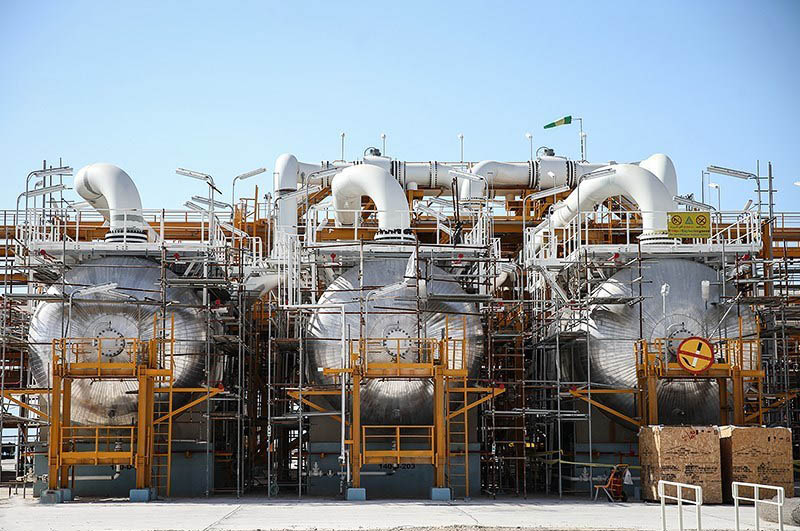by Sara Vakhshouri
Unlike early 2017, when Iran’s energy industry started a year full of hope and prospects of potential growth, 2018 has started with different potential risks targeting its energy industry and production growth. Risks abound, particularly the prospect of additional sanctions and domestic instability.
On December 28, the largest protests in Iran since 2009 broke out in the northern city of Mashhad and quickly spread to cities and towns across the country. Unlike previous demonstrations, in which primarily urban, middle class protesters raised political grievances, these risings began among poorer, more rural Iranians spurred on by economic factors. As of the first week of January 2018, more than 22 people had died and security forces had arrested thousands.
The protests spread from the northern city of Mashhad all the way to southern cities that host major oilfields, ports, and refineries, like Abadan, Mahshahr, Khomeini Shahr, Masjid Suleiman, as well as major cities Tehran and Shiraz that host refineries.
Since then, Iranian government and security forces have taken strong measures to secure the oil and gas fields and other energy centers and hubs inside the country, like ports, refineries, petrochemical units, and power plants. These security forces are certainly capable of maintaining security in sensitive areas and the country’s energy centers, so protestors are not likely to get inside or attack the country’s energy facilities. Nor are labor strikes likely inside the energy units. Even if such a strike were to happen, security forces could easily control it. As such, the current protests won’t likely cause any major, long-term supply interruptions, unless the strikes spread to major energy centers, fields, refineries, and ports.
The greater risk to Iran’s oil facilities is sabotage. Despite the ability of Iran’s security forces to defend facilities from external threats, energy facilities are vulnerable to possible acts of destruction by their own workers. The recent unrest is led by poorer people demanding a better economic situation, a demographic that is well represented in Iran’s oil fields and production facilities. Most of the workers in the operational facilities are laborers who receive low wages and are susceptible to joining the protests.
Compounding the risk, no visible public figure has so far emerged as a leader of the protests, so the government has no specific person to target. Different power centers have blamed different sources for the unrest. This uncertainty makes it difficult for security forces to guard against possible uprisings at energy production facilities.
People in the southern cities have long complained about the poor economic conditions in their hometowns despite the presence there of the country’s major oil and gas resources. The high rate of air and water pollution in these regions compounds local grievances. The discontent extends beyond the Sunni and Arab populations, who do not receive equal attention from the government, to include Persian and Shiite citizens, who feel the government has neglected the economic wellbeing of the region.
In cities like Assalouyeh in South Pars, where people breathe natural gas instead of oxygen, it only takes one angry worker to ignite massive disruptions. Small destructive actions could have a bigger impact on the country’s production and supply flow than larger labor strikes that the security forces could easily stop. It took almost 60 days for Iran’s Central Oilfield Company to put out a fire caused by an explosion in October 2017 at one of the drilling rigs on the Ragsefid oilfield. Iranian leader Ayatollah Khamenei announced that an “external enemy” has directed the current protests. If this is the real cause of the unrest, then this “external enemy” could also disrupt Iran’s energy facilities.
Another major concern for Iranian energy officials is possibility of cyber-attacks on their operational facilities, from groups or countries that support the unrest in Iran and are benefiting from the instability.
In fact, there have been a series of recent incidents in Iran’s energy centers, including an explosion at a Tehran refinery in October 2017 and a condensate supply interruption in South Pars in September 2017. The cause of the explosion at the Tehran refinery was attributed to a leak of petroleum products. Officials cited the same cause for the cut in South Pars production. NIOC officials later announced that a leak led to the condensate production cut in the last quarter of 2017. The exact location of the leak was not announced, but Iran’s condensate export dropped about 50,000 to 80,000 barrels per day due to the production cut from September until December 2017. (Iran’s condensate exports during these months were even higher than this, but the supply cut was due to a rise in domestic use).
As soon as Iran’s condensate export was back on track, another incident interrupted the supply. An Iranian oil tanker carrying 136,000 metric tons of condensate for Hanwa Total Petrochemical Co., the largest buyer of Iran’s condensate, collided with a Chinese freighter on January 6. The tanker was on fire for the past two days, and 31 of its 32 crew members remain missing. If sanctions on Iran’s oil exports are reimposed, consumers who want to purchase Iranian oil and products will face additional risks since the sanctions may well extend to international insurance coverage that would ordinarily kick in after such incidents. Under the nuclear sanctions, Iranian tankers and cargoes were not allowed to use international insurance and were instead insured by domestic insurance companies.
Even if there is no solid evidence to link the current incidents in Iran’s energy centers to domestic or foreign opponents of the Iranian regime, Iran’s energy facilities have been facing a series of technical problems. Iran does not have a prior history of such a consistent series of incidents, and most of these incidents have happened in the same way: “leakage of products and explosion.”
Furthermore, most of these incidents have targeted Iran’s petrochemical output and storage capacity, an arena where Saudi Arabia and Iran intensely for market share. Although Saudi Arabia enjoys higher production capacity, Iran maintains price leverage as it uses its abundant natural gas as a component for other products. Natural gas is significantly cheaper than the liquid fuel used by Saudis in their petrochemical facilities. Other major incidents have happened in South Pars, which supplies the huge petrochemical facilities in this location.
Timeline of explosions and destructive incidents in Iran’s energy facilities in 2015-2017:
-
December 2015: explosion in Marun Petrochemical unit
-
May 2016: explosion in Tondguyan Petrochemical unit
-
June 2016: explosion in Petrochemical storage in Islam-shahr
-
July 2016: explosion in the Bu-Ali Sina Petrochemical Facility in the Bandar Iman Special Economic Zone.
-
March 2017: explosion in Morvarid petrochemical
-
September 2017: explosion in Bushehr Petrochemical
-
September 2017: leak in one of the phases of South Pars
-
October 2017: explosion in Tehran refinery
-
October 2017: explosion of oil rig number 95 on well 147 in Ragsefid oilfield
-
December 2017: explosion in Kaveh Petrochemical
-
January 2018: Iranian oil tanker collides with a Chinese vessel and burns in fire.
The Saudis have reacted on social media in interesting ways to the incidents in Iran. For instance, the Saudis circulated videos of the explosion and fire in Bu-Ali Sina petrochemical as #Iran-Tahtarigh on social media. The “Al-Ahwas Eagle Brigade,” a Sunni group that opposes Iran’s Islamic Republic and seeks the freedom of Southern city Ahwaz, claimed responsibility for the explosion and fire of the Bu-Ali Sina Petrochemical facility in the Bandar Iman Special Economic Zone.
Iranian media immediately countered this announcement and the Saudi tweets by reporting that the incident was just a technical error and not a terrorist attack.
None of these incidents has caused a major production cut or considerable damage to production capacity. In fact, Iranian supply has been fairly consistent and even grew in the past year. Nevertheless. whether foreign attacks, domestic sabotage, or simply technical errors have caused these incidents, the outcome is the same: the interruption of Iran’s energy supply. If the cause is not addressed, the interruptions will persist.
Beside the aforementioned incidents and the protests in Iran, investors are also concerned about possible additional sanctions targeting Iran’s energy industry. These sanctions could range from the possible renewal of nuclear sanctions by President Trump to additional international limitations and sanctions over Iran’s ballistic missiles. Because of allegations that Iran provided the missile the Houthis launched at the Saudi capital of Riyadh in November 2017, international concerns over Iran’s ballistic missile program and the possibility of further international pressure on Iran have been strengthen (even among European countries that support the nuclear deal). As a result, international sanctions could once again target Iran’s oil export flow and income.
Photo: South Pars onshore facility (Wikimedia Commons)






Cut the money used for hezbollah, syria, gaza and all of those ponzi foundations called bonyads zaheremar va mostara iranouni and increase the wages of those who are working reduce their income taxes and increase vat. Change and modernize the law and set clear AML rules in line with FATF, you will see, you will add up to 5 basis point al least to the growth of gdp
Thanks for that useful and interesting post ….
I’m not Iranian but I’ve been an Iran-watcher for many years, and I have found little quarrel with whatever they decide to do. Subjected to the greatest pressure imaginable from the most powerful country on earth, Iran had always come up a winner. That makes me a Persianophile?
“In fact, Iranian [energy] supply has been fairly consistent and even grew in the past year.” And In fact, Iran-Europe trade is way up.